9 proven marketing automation workflows (examples & templates)
Marketing automation workflows are sets of rules used to automate different steps of the marketing process. For years, they’ve helped teams streamline time-consuming marketing tasks, mainly around sending emails, managing leads, and sharing data between systems.
Updated on 10 Oct 2025
However, many teams are still only scratching the surface of standard email marketing automation. At the same time, there are plenty of ways to use marketing automation to achieve strategic goals across other channels and use cases, like:
- Delivering relevant content and product recommendations that drive revenue at each brand touchpoint.
- Improving lead generation and nurturing potential customers down the sales funnel.
- Promoting new products in a relevant and engaging way.
- Recovering abandoned shopping carts.
- And much more.
In this guide, we’ll explore nine proven marketing automation workflows that can help you do these things (and more). The first six are simple but powerful workflows that span one or two channels, while the last three are complex custom workflows, which our customers have used to improve revenue, ROI, and other key results.
6 simple and powerful marketing automation workflows
We’ll begin this list with some well-known but essential workflows that most online businesses should implement and optimize.
Before we dive in, note that you can build all of these workflows with Insider — our AI-native platform for individualized, cross-channel customer experiences. Our solution offers:
- A flexible marketing automation tool for 12+ channels. You can use it to build automated workflows with a simple drag-and-drop editor across your website, mobile app, email, SMS, WhatsApp, and more.
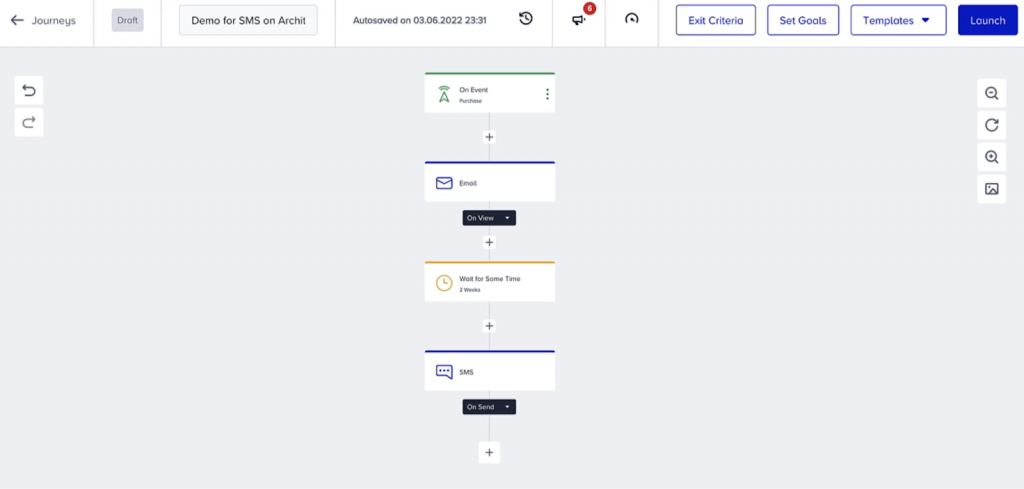
- AI-powered features that save you time and optimize your workflows. These include send-time optimization, next-best channel selection, A/B test winner auto-selection, and more.
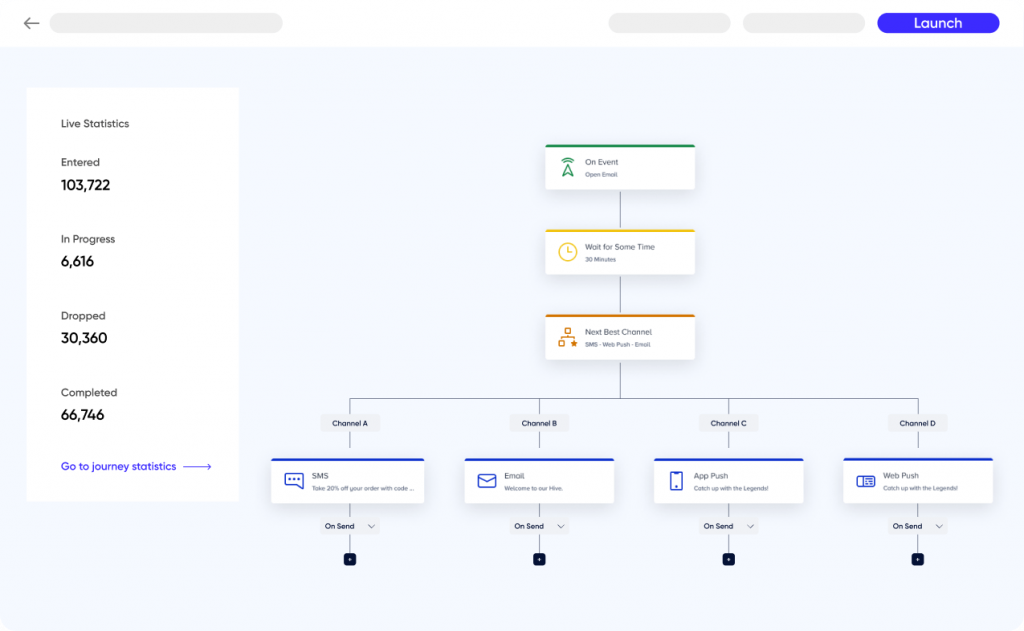
- A plethora of workflow templates for tons of use cases and industries. Each template can be easily customized to your needs without any coding.
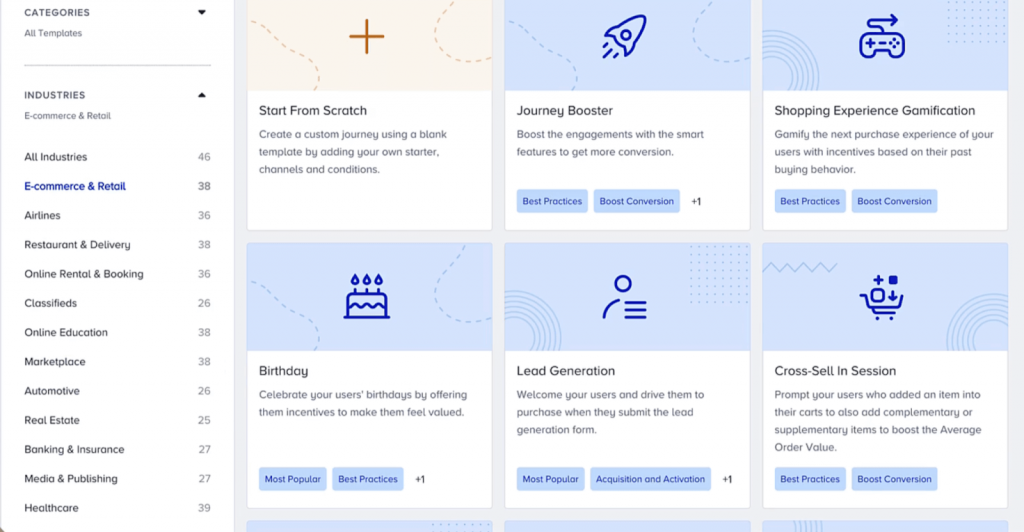
1. Workflow for welcoming new email leads
Pretty much every online brand has some type of automated welcome email sequence for new leads. However, few brands actually make the most out of these workflows as they just send one standard message to their entire email list.
At the same time, a good welcome workflow can do so much more — like guiding users to their first purchase quickly and efficiently. This can be done by creating an automated sequence of emails (instead of sending just one) and personalizing it based on users’ actions.
For instance, Remix used a three-step email marketing campaign for their lead nurturing needs:
- If new subscribers don’t make a purchase one week after registering, Remix sent an email prompting them to save their preferred search filters.
- After a few days, a follow-up email is triggered. Its goal is to showcase a list of brands available on the site and how to mark one as a favorite.
- The last email offers details on how to save money by combining orders.
This drip email campaign resulted in a 104% jump in first purchases compared to the previous quarter.
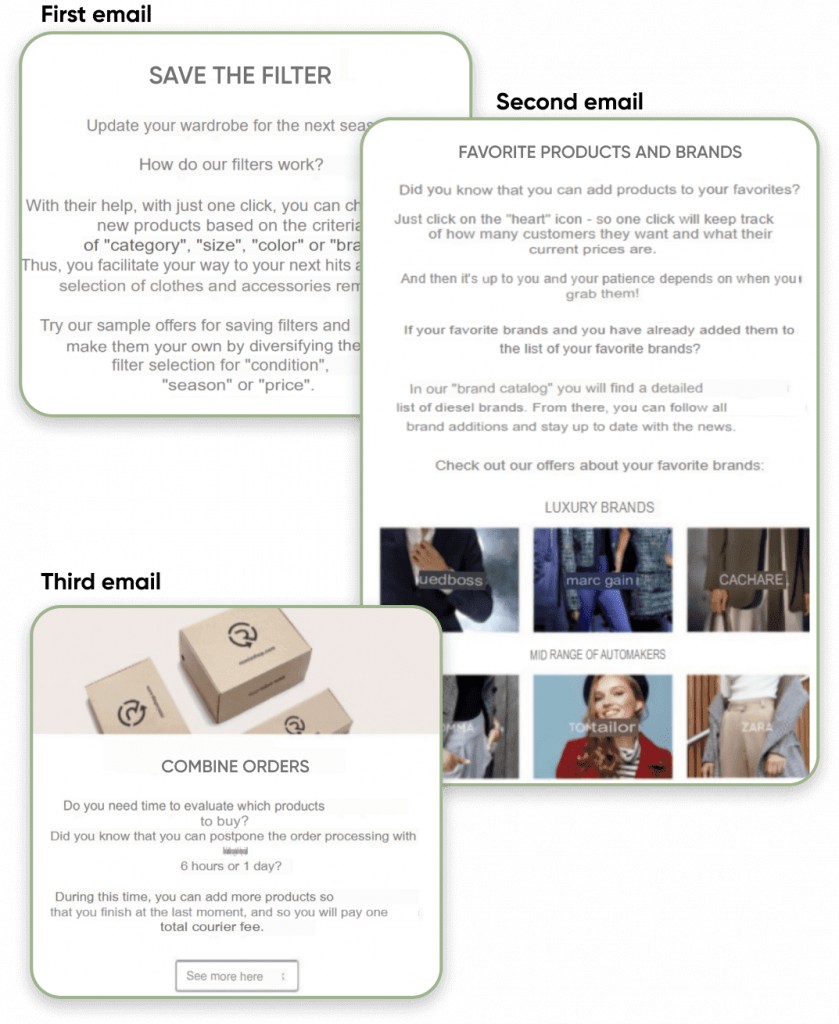
You can take the same idea and apply it to your unique business needs by:
- Starting with an email survey to gather first-party data and continuing the workflow in different ways depending on the answers.
- Creating different flows depending on the source that led new leads to your site (e.g., social media, email newsletters, and so on).
- Building a distinct onboarding journey for users who browsed a specific category on your site.
2. Workflows for recovering abandoned carts
Cart abandonment remains one of the biggest problems in the world of eCommerce. Any marketing team that’s looking to maximize their budget and revenue should constantly be looking for ways to get cart abandoners to complete their purchase.
Insider helps you do this by automatically creating segments of cart abandoners and letting you easily add cart items to your emails, push notifications, and messaging channel communications.
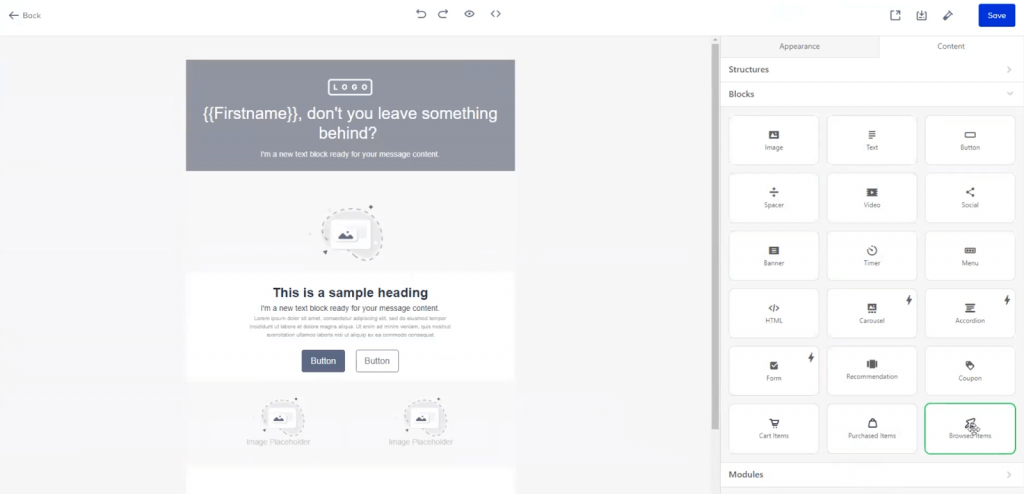
You also have ready-made cart recovery templates for different channels. These templates are easily customizable, so you can adjust their colors, branding, and other elements without any coding (or even changing the HTML).
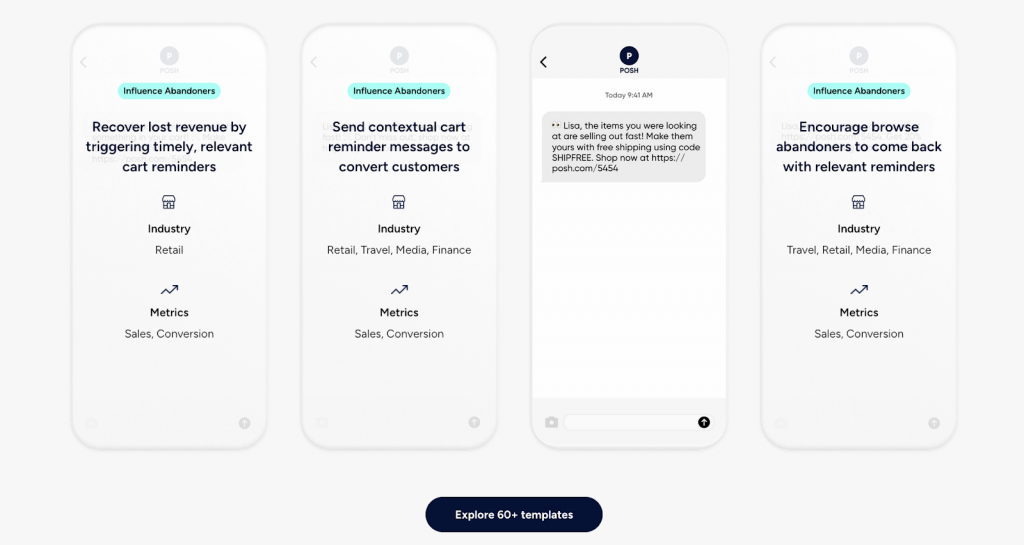
Here are a few of the channels that our clients use to recover lost carts:
- Email and SMS, which is the most widely-used combination of channels by retail brands worldwide. Slazenger used both channels to build cart recovery campaigns that produced a 49x ROI in eight weeks (we’ll discuss their use cases later in this guide).
- WhatsApp, which is an underutilized but extremely powerful channel for recovering potentially lost revenue. Picniq used it to achieve an 80% open rate and a 5x ROI on their cart abandonment campaigns
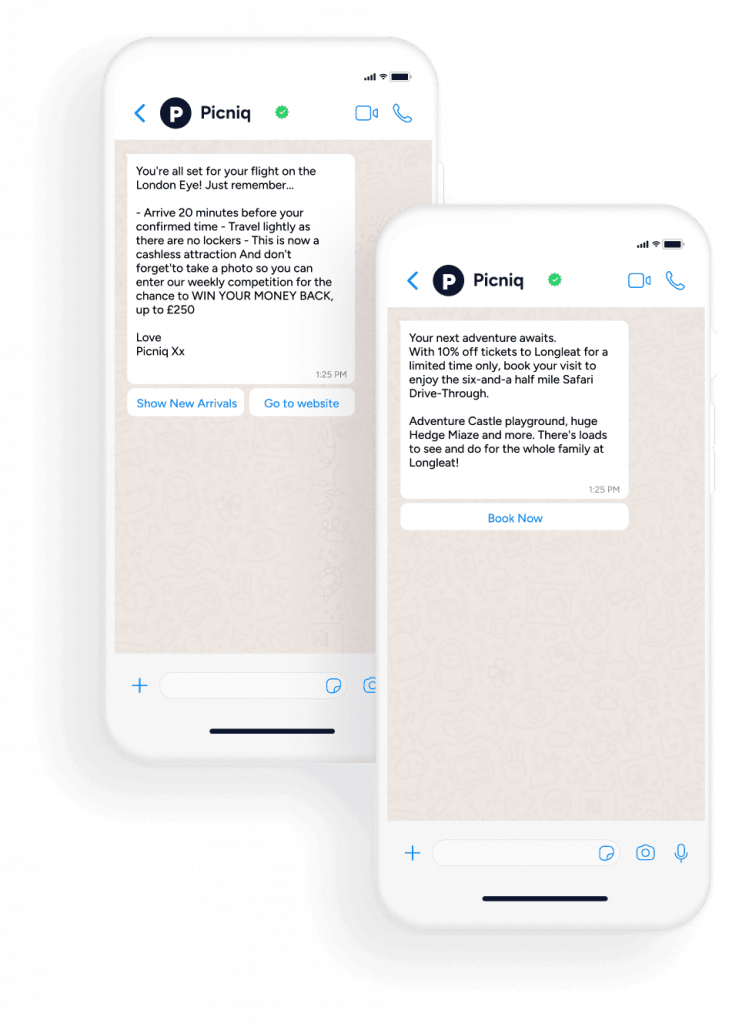
- Web push notifications, which can be incredibly powerful and cost-effective compared to traditional channels like email and SMS. Marks & Spencer used push notifications to achieve a 15.1% cart recovery rate, compared to the 3% industry average for abandoned cart emails.

3. Workflows for confirming orders and purchases
Transactional flows are a must for any online business. That’s why most eCommerce platforms and content management systems (CMSs) have built-in automated email workflows that trigger immediately after a successful transaction.
However, you don’t need to limit yourself to email. For example, with Insider, you can also send confirmation messages on channels like SMS and WhatsApp. Again, we have plenty of templates to make the process easier, like the WhatsApp message template shown below.
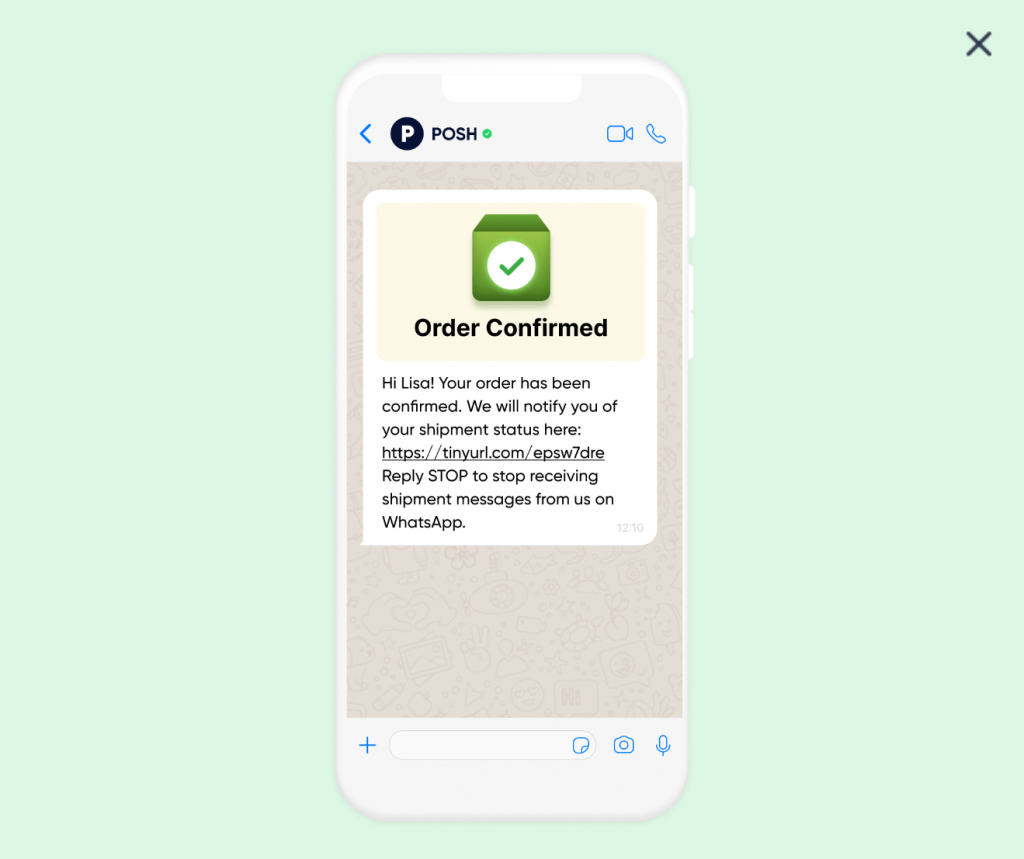
All you need to do is set our journey builder to trigger your emails or messaging channel communications immediately after a successful purchase event. Then, you can build strategic follow-ups for promoting other products after a set amount of time, as we’ll discuss in a bit.
4. Workflows for sending targeted price drop and inventory alerts
These workflows are powerful for targeting users on the verge of making their first purchase, as well as those with a high discount affinity.
Since Insider automatically collects data about each user’s interests and preferences, you can use that information to trigger emails, push notifications, or SMS and WhatsApp messages whenever:
- Products that users have been browsing are back in stock.
- Products that users have shown interest in get a price reduction.
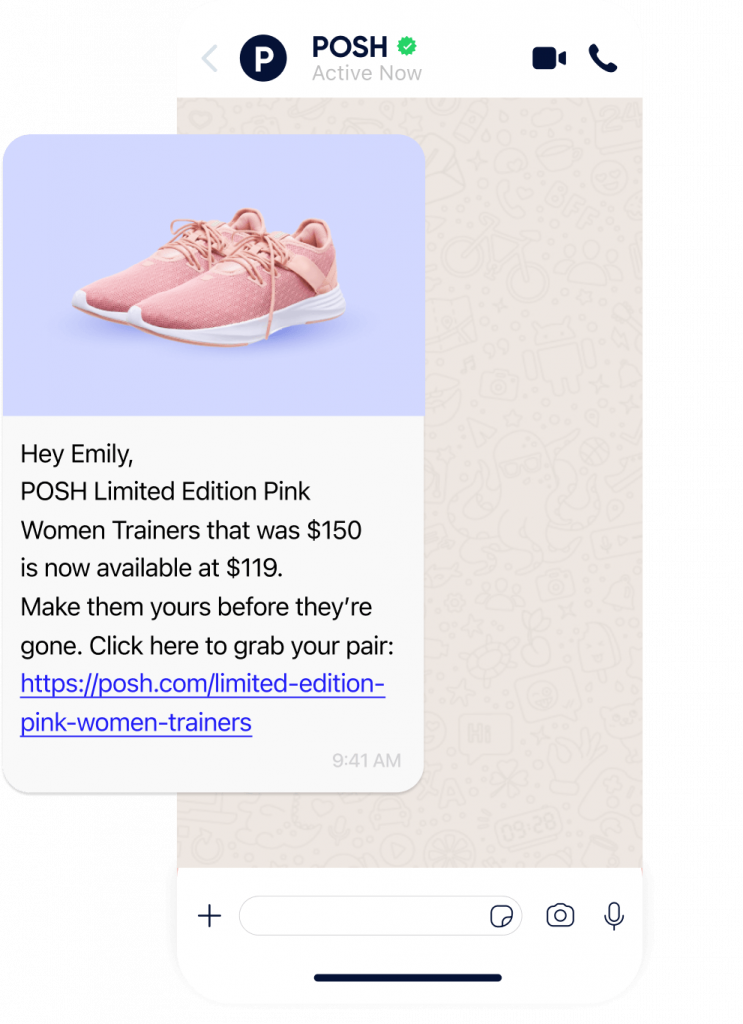
In both cases, your messages have a much higher chance of engaging new customers as they’re based on their needs, interests, and preferences.
At the same time, you can get even more targeted with our AI-powered predictive segmentation. Specifically, you can use our platform to only target customers with a high discount affinity who are much more likely to respond to a price drop alert.
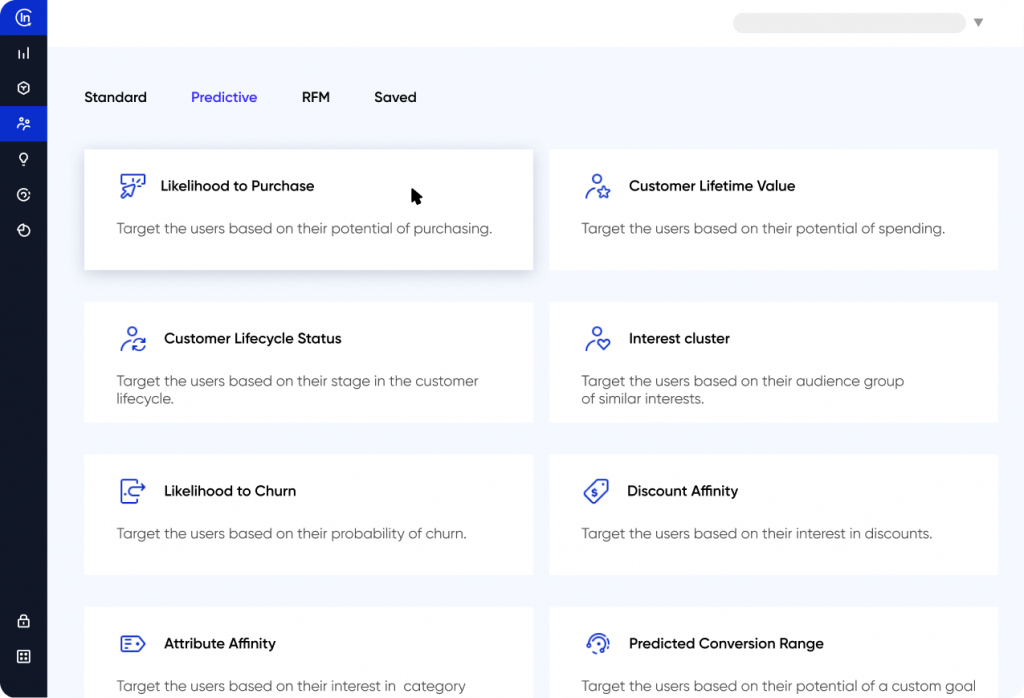
This tactic also guarantees that you’re not wasting discounts on people who might’ve bought a product at its regular price.
5. Workflows for upsells and cross-sells
Upsells and cross-sells can help you drastically increase key metrics like average order value (AOV), customer lifetime value (CLTV), and customer retention. That’s why you should find strategic places during the customer lifecycle to implement upsell and cross-sell workflows.
For example, you can build marketing automation workflows that automatically:
- Suggest products that are frequently purchased with the one currently in the customer’s cart. This can be done with a good product recommendation engine that analyzes browsing and purchase history, as well as real-time behaviors, to deliver relevant recommendations across landing pages and channels like email.
- Employ this same strategy but on a channel like SMS or WhatsApp a few days or weeks after a customer has completed their first purchase.
- Generate upsell and cross-sell opportunities by offering discounts on customers’ registration anniversaries, birthdays, or other important events.
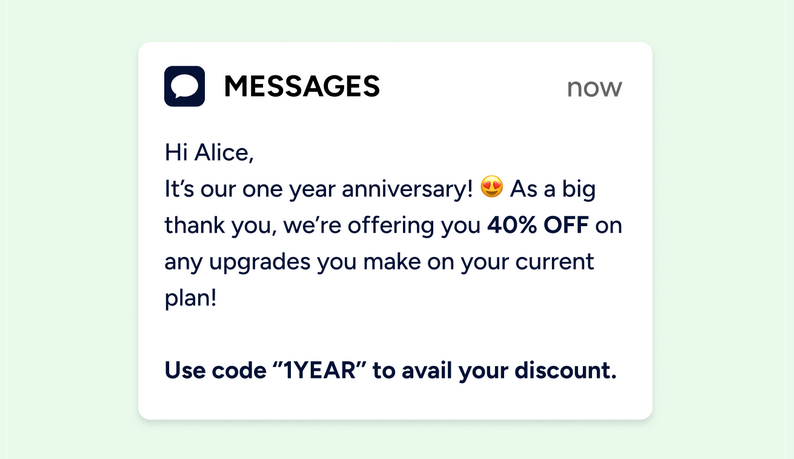
6. Workflows for pre- and post-purchase feedback
With the cookieless marketing era upon us, teams need to rely much more heavily on zero- and first-party data gathered directly from customers. That’s why it’s crucial to have workflows for collecting that information at different stages of the customer journey.
The classic way to do this is by sending a post-purchase email survey that asks customers to rate your product and the overall experience. This can also be done on messaging channels like SMS or WhatsApp, depending on your customers’ preferences.
One way to take this tactic to the next level is by using AMP emails. The AMP technology lets customers answer surveys directly in the email, without having to go to your site or app.
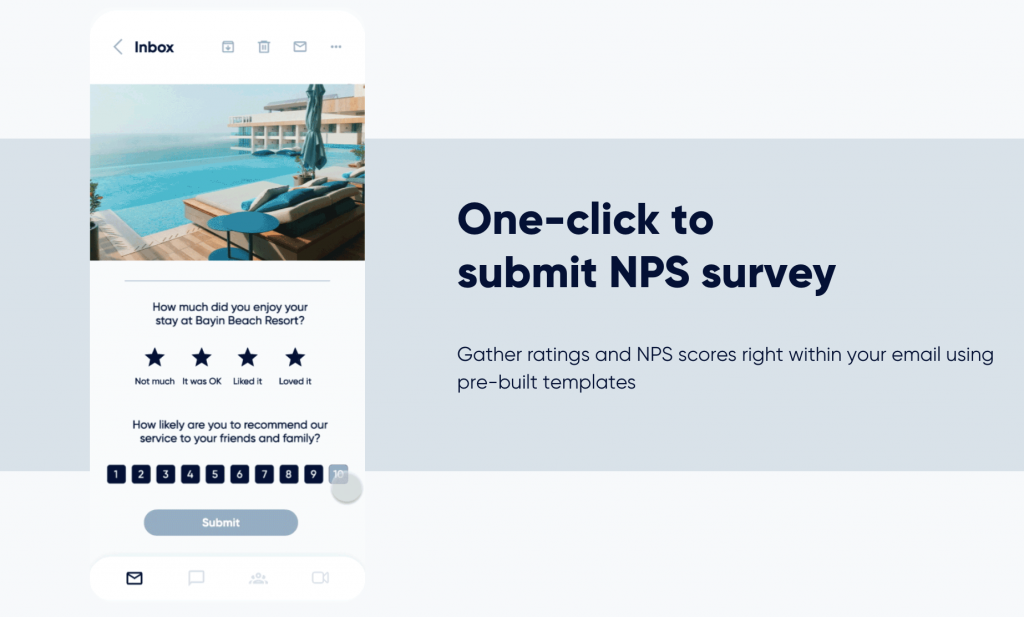
This removes a lot of friction from the process and ensures you get more answers from your customer base.
At the same time, you can also use AMP emails to gather valuable customer data pre-purchase. For example, you can ask them what content or products they’re interested in, so you can tailor your follow-up communications to their interests.
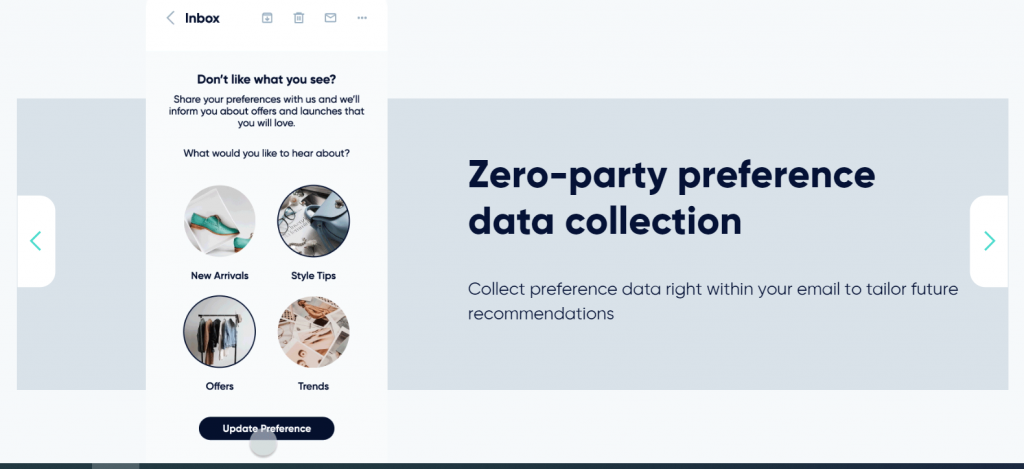
Advanced marketing automation workflows for cross-channel use cases (with examples)
The workflow examples we explored up to this point are relatively simple in the sense that they span only one or two channels and use cases. However, things get trickier when dealing with custom workflows in the context of omnichannel marketing automation.

Below, we’ll look at three examples of companies using custom automation workflows that span across multiple channels. All three automation examples are powered by Architect — our customer journey builder and marketing automation platform.
7. Lead validation and promotion workflows across web, email, web push, and SMS
Generali is one of the world’s largest insurance and asset management companies in the world. After using Insider to integrate their customer data and increase leads by 3x, they needed to build an automated lead validation workflow.
This workflow’s goal was to give each lead a score based on their website visits. That would allow the sales team to focus on the leads with the highest purchase intent. It would also make it possible to send each lead relevant information at the right time.
Our local support team helped Generali build this lead-scoring project from scratch. Now, each lead in their system automatically accumulates points based on their interactions with the website.
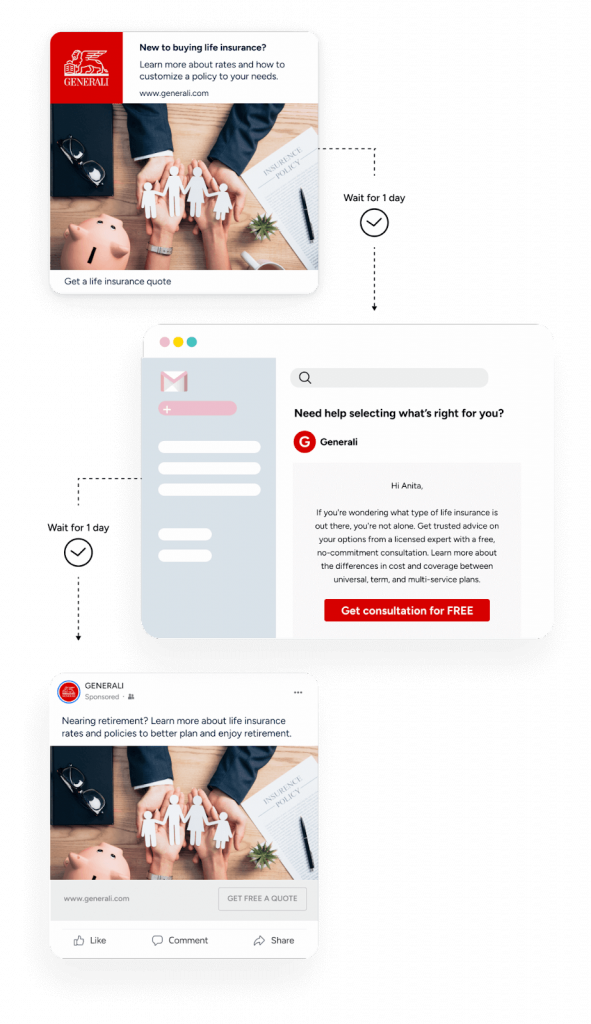
From here, Generali also started using Insider’s marketing automation capabilities to send personalized, timely offers across email, SMS, and web push to each lead, based on what they showed interest in.
On top of the big increase in leads, Generali’s new automated workflows also led to a 20% reduction in sales cycle length.
8. Cart abandonment and price drop workflows across email, SMS, and web push
Slazenger is one of the world’s most established sports brands. They started working with Insider with the goal of delivering exceptional, personalized customer experiences across key brand touchpoints.
This included the creation of different marketing automation workflows, including:
- Cross-channel cart abandonment workflows. Slazenger’s first marketing campaign was aimed at sending reminder emails and follow-up communications to nudge cart abandoners to return and complete their purchases. With Insider, they were able to target shoppers with automated notifications on their preferred channel — on-site, web push, or email — and send them a follow-aup coupon code via SMS. These marketing automation workflows delivered a 49x ROI in just eight weeks.
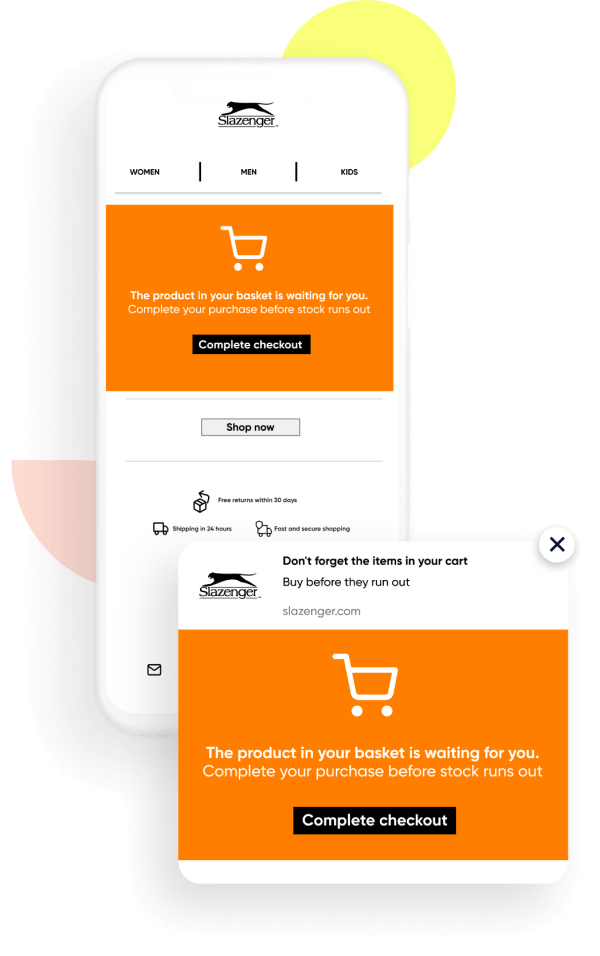
- Price drop notification workflows. Slazenger also wanted to improve its email CTR and conversion rate via timely communication and personalization. To do that, they started using Architect to send targeted price drop emails and web push notifications to customers who viewed the product or added to their wishlist (or cart). This helped Slazenger drive more conversions and increase email CTR by 12.1% compared to their other campaigns.
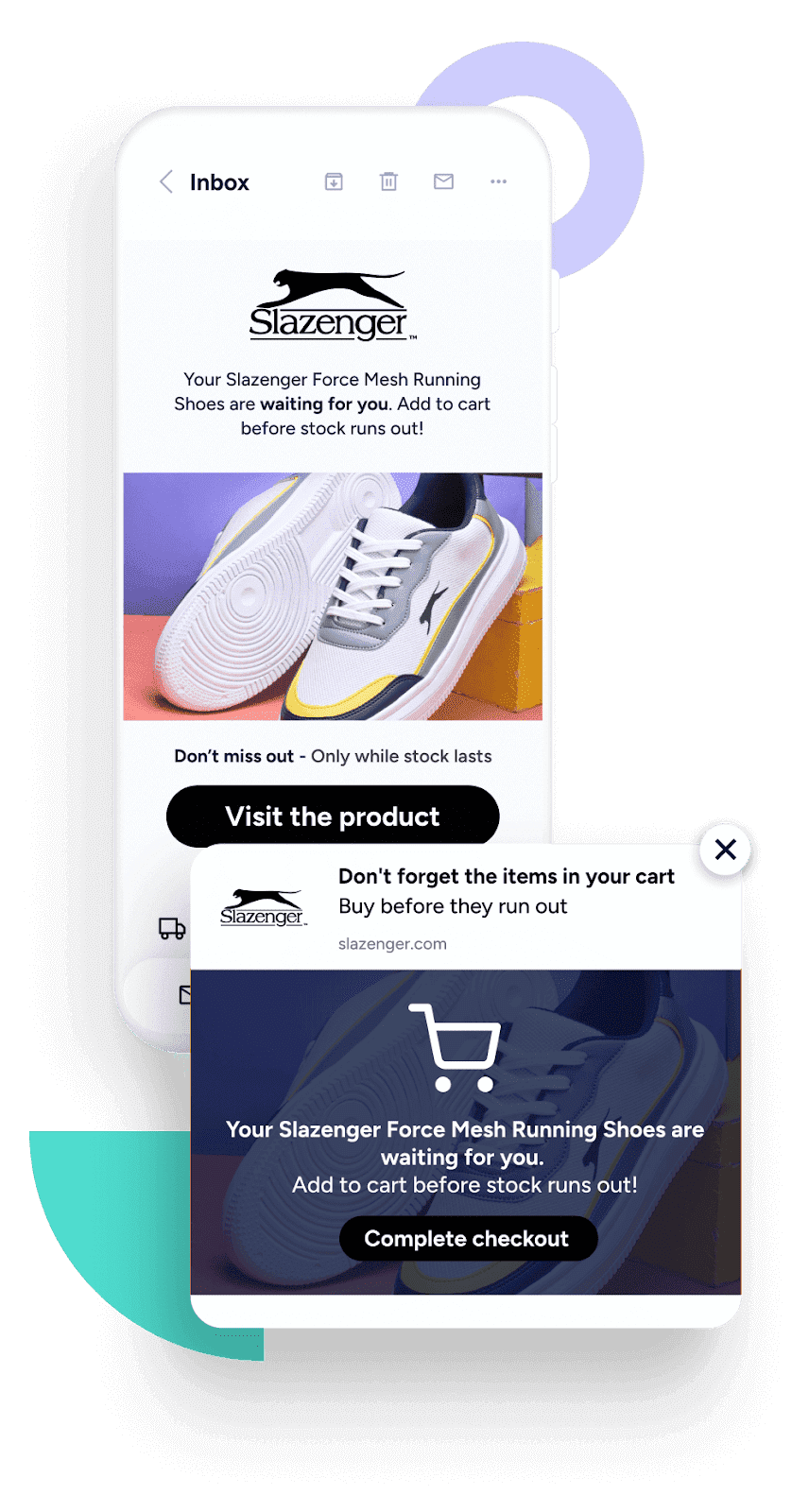
As a next step, Slazenger will experiment with another popular workflow automation strategy — automated back-in-stock campaigns.
9. Promotional workflows across web, mobile, email, push notifications, and SMS
NA-KD is a fast-growing fashion brand operating across Europe. After consolidating their customer data with our eCommerce CDP, the company needed to redefine their marketing strategy to create better customer experiences and drive more sales.
They had used standard campaigns and coupon-based techniques that didn’t produce the desired results. That’s why they started building new automated workflows that were personalized to each customer.
Using Architect, they were able to implement these flows across five channels — their website, mobile app, email, push notifications, and SMS. These new automated and personalized campaigns resulted in a 25% increase in CLTV and helped the brand drive a 72x ROI in 12 months.
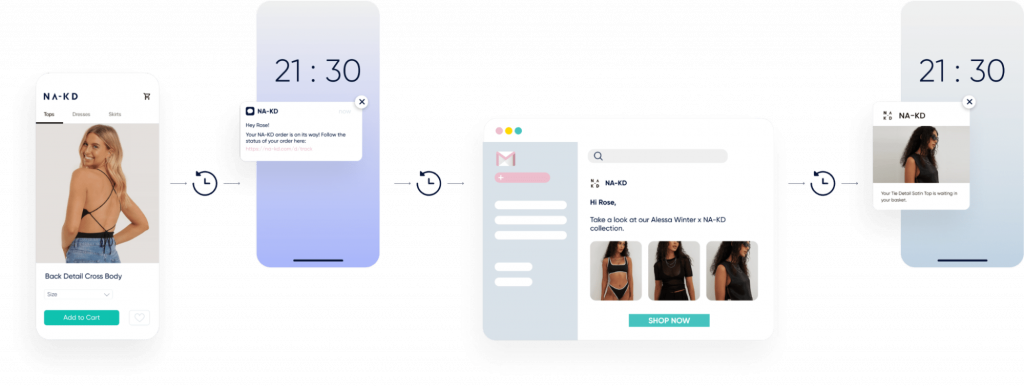
Tap into the full potential of marketing workflow automation with Insider
Insider can help you build and automate all kinds of marketing workflows that serve your and your customers’ needs. Thanks to our platform’s broad channel access and versatile marketing automation software, you can create automated journeys across 12+ channels — including websites, mobile apps, email, push notifications, SMS, WhatsApp, and others.
Plus, Insider is much more than just an automation solution. Our robust enterprise marketing platform can also help you:
- Unify your customer data — from APIs, CRMs, content management systems (CMSs), analytics tools, and any other online or offline source — into a central database. This helps you overcome data silos and powers your marketing efforts with reliable insights. Learn more: 8 Best customer data platforms (by category).
- Segment your target audiences using standard, predefined, and predictive characteristics. For example, our platform’s AI-powered algorithms can predict how much customers are projected to spend and how likely they are to buy or engage on a specific channel.
- Tap into the full potential of AI and machine learning. Insider brings together a unique mix of predictive, generative, and conversational AI capabilities under one roof. You can use them to streamline or completely automate repetitive tasks, anticipate future behaviors, and engage in unstructured two-way conversations across messaging channels.
- Personalize every customer touchpoint. Our industry-leading personalization engine can tailor content, messaging, and product recommendations to each customer’s interests, needs, and preferences. This can help you form long-term, profitable customer relationships and improve key metrics like customer engagement, conversion rates, revenue, and more.
Finally, our easy channel integrations, experienced support team, and versatile templates will help you set up effective marketing automation workflows as quickly as possible.
Schedule a demo with our team to learn how Insider can benefit your business specifically.



















